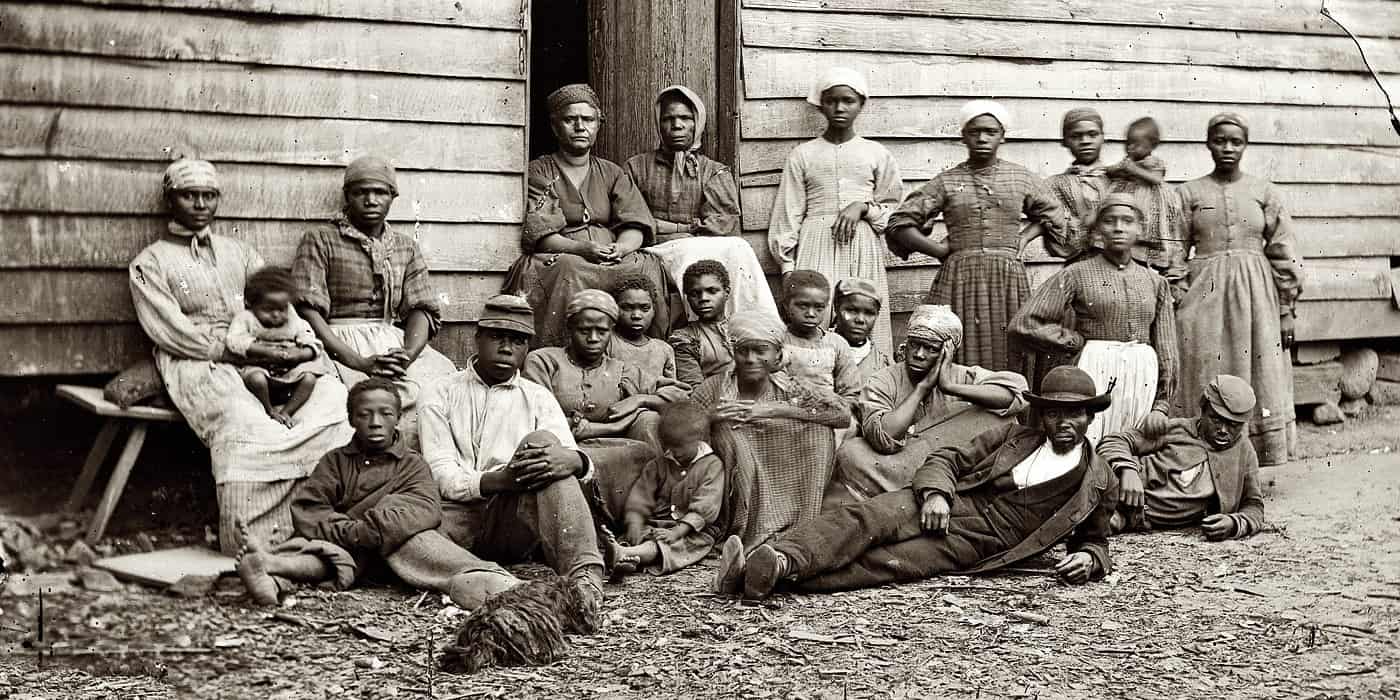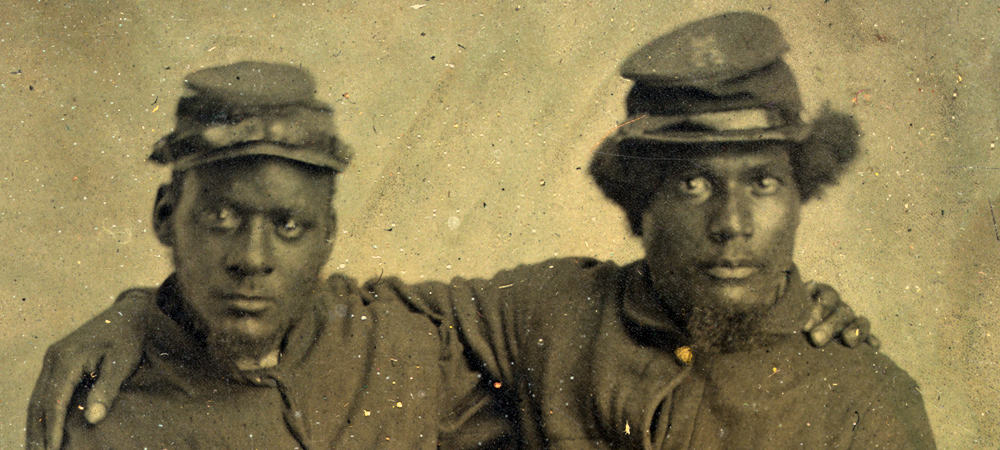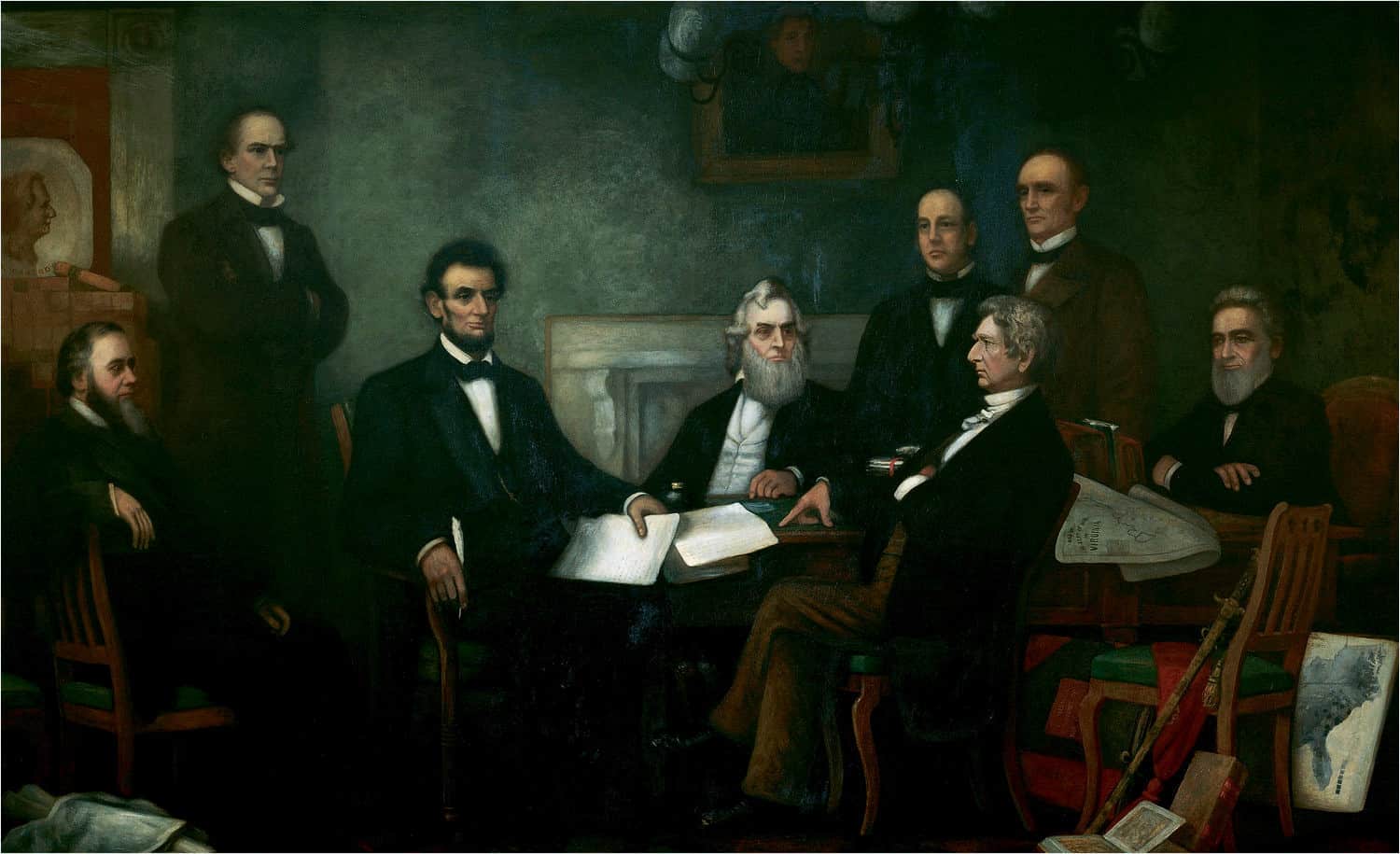![This large, detailed allegory predicts the triumph of the Union over the dark forces of the Confederacy and “King Cotton.” The accompanying key, seen below the image, describes the secession of the South in intensely moralistic terms, as the machinations of a cunning “Hydra of human discord” that produces treachery and rebellion. The image can be divided into a lower and upper half. In the lower, the forces of darkness are ruled by King Cotton, pictured here as Below are the forces of darkness ruled over by King Cotton, shown here as an alligator-headed monarch with a body of a cotton sack. The terrifying monster sits on a throne next to a burning column with the words “Lecompton” (the controversial proslavery Kansas constitution passed in 1857), “Fugitive Slave [Law],” and “Missouri Compromise.” With pistols and daggers in his belt, King Cotton seemingly maintains control over his land, keeping a paw on a manacled slave who looks upward toward a “sublime apparition” appearing in clouds the clouds above. Here Freedom, wearing an Indian bonnet and holding a liberty cap, appears with a large American flag amid a crowd of deities and historical figures, including George Washington, Benjamin Franklin, and Thomas Jefferson. Christianity (left) and Justice (right) attends Freedom. Immediately in front of her is “Humanitas,” borne by an eagle and holding an infant and reaching towards the supplicant slave below. The eagle fiercely clutches the hem of King Cotton’s cloak and wields several lightning bolts, which have ignited the terrified monarch’s throne. Other symbols of slavery are terrorized by this vision of the Union’s triumph.](http://www.abolitionseminar.org/wp-content/uploads/2013/12/Triumph.jpg)

In August of 1861, Congress passed the First Confiscation Act, which provided Union military commanders the authority to liberate enslaved people used to support the Confederacy. This action spurred further runaway slave activity to Union lines and prompted abolitionists to call for more abolitionist laws in the wartime union. African American enlisted in droves, and the sacrifice of these men further emboldened calls to end slavery. African American poet Francis Ellen Watkins Harper wrote a moving tribute to the black soldiers of the 54th Massachusetts.

By April 1862, when Congress ended slavery in the District of Columbia, the federal capital already had thousands of fugitive slaves, a fact that had doubtless inspired politicians to enact an emancipation law. Another example shows that enslaved people, reformers, and politicians often worked together to shape emancipation in the Civil War. At Fortress Monroe in Virginia in May of 1861, three, enslaved men escaped to Union lines in search of freedom. Their heroic act proof that African-Americans would risk much to gain liberty. But the trio’s action also compelled Union commanders to respond to potentially emancipatory events on the ground. Yet they could easily have been returned if the Union military commander, Benjamin Butler, deemed it proper policy to do so; however, he did not return them to bondage, illustrating the importance of Union allies in slavery’s destruction in the South. Nor did President Lincoln overturn Butler’s decision to retain the enslaved men, further illuminating the way the Union chain of command could frame the possibility of southern emancipation.

This last point became clear a few months after the incident at Fort Monroe, when Lincoln countermanded a mini-emancipation proclamation issued by Gen. John C Fremont in Missouri. While black and white abolitionists celebrated union policy at Fort Monroe, they condemned Lincoln’s and the union’s retrograde action in Missouri. In doing this, they showed that emancipation would require multifaceted action to truly destroy the bondage of 4 million people in the South. In fact, when Lincoln issued his final Emancipation Proclamation on January 1, 1863, he knew from military reports that thousands of enslaved people had fled their masters in hope of freedom. He now hoped that enslaved people throughout the Confederate South would rush to Union lines, literally hollowing out the secessionist cause. Thus, even Lincoln realized that he alone could not end bondage by the stroke of the pen. He needed enslaved men and women to act decisively for their freedom as well. It worked the other way too: enslaved people in reformers came to see the importance of national abolitionist laws. Indeed, even when the Civil War ended in the spring of 1865, both abolitionist and antislavery politicians realized that a reconstructed union might very well find ways to reestablish slavery if there was no definitive abolitionists law — like a constitutional amendment banning bondage — on the federal books. Final freedom in 1865 thus required the exertions of enslaved people, abolitionists and antislavery politicians alike.
Videos
Freedom National: The Destruction of Slavery
Historians have debated who freed the slaves, with some crediting Abraham Lincoln, others the Union Army, and others look to the slaves themselves. Historian James Oakes’s award-winning book argues that the Republican Party had deeply committed antislavery sympathies and worked to attack slavery from the very beginning of the Civil War. Professor Oakes explains his arguments and research with students of the Abolition Seminar.
Robert Smalls: A Daring Escape
Robert Smalls was a 23-year-old slave pressed into service for the Confederacy aboard a warship called the Planter. For nearly a year, he quietly observed the movements of the ship and its crew. Just before dawn on May 13, 1862, Smalls took his chance. While the ship’s officers slept ashore, he and his fellow slave crewmen pulled anchor and eased the Planter into Charleston Harbor. They had prearranged to meet their family members. Together they embarked on an extremely dangerous journey.
Lesson plans
- The Emancipation Proclamation: Freedom’s First Steps – While the Civil War began as a war to restore the Union, and not to end slavery, by 1862 President Abraham Lincoln came to believe that he could save the Union only by broadening the goals of the war. The Emancipation Proclamation is generally regarded as marking this sharp change in the goals of Lincoln’s war policy. Through examination of the original document and related writings, students can return to this “first step” and explore the obstacles and alternatives we faced in making the journey toward “a more perfect Union.”
